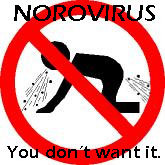Rob Mancini, a public health inspector for the Canadian province of Manitoba, writes:
Norovirus is the leading cause of domestically acquired foodborne illness. Noroviruses are highly transmissible and can spread via exposure to contaminated food or water sources, person-to-person contact, aerosolized vomitus particles, and fomites1. Their high infectivity, extreme stability, resistance to disinfectants, and ability to cause disease has categorized them into a Category B biodefense agent1.
The incubation period typically ranges from 12-24 hours with predominant symptoms of vomiting and diarrhea, somewhat similar to vomitus scene from the acclaimed film The Exorcist. In an effort to part from the insidious sub-zero temperatures in Winnipeg (Canada), my wife and I recently took a trip to Mexico only to be taken down from norovirus. Never felt an episode of fooborne illness quite that bad and those who have had norovirus can relate.
The University of Liverpool is to lead a £2 million Food Standards Agency (FSA) project to map the occurrence of norovirus in food premises and industry workers
The study is a collaboration between the University of Liverpool’s Institute for Infection and Global Health, Public Health England, the Centre for Environment, Fisheries and Aquaculture Science, the Food and Environment Research Agency, Leatherhead Food Research and the University of East Anglia.
This follows a recent draft report by the Advisory Committee on the Microbiological Safety of Food, which called for improved routine surveillance and investigation of foodborne viruses. At present it is not clear whether the majority of infections come from the food itself or from the people and environment involved in bringing it to the plate.
Researchers will produce data to assist the FSA in developing plans to reduce the infection by collecting swabs from work surfaces at more than 200 pubs, restaurants and hotels in the North West and South East of England. The team will also investigate occurrences of the virus in shops in three of the highest risk foodstuffs: oysters, salad and berries. The results will be combined with those from other research programmes to generate an assessment of the true impact of the virus on infection in the UK.
1. Karst SM (2010) Pathogenesis of noroviruses, emerging RNA viruses. Viruses 2: 748–781.

